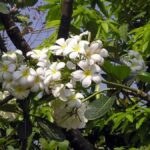Artemisia vulgaris, commonly known as mugwort, is a versatile plant with a multitude of names and uses. It has been called “thuốc cứu” in Vietnamese, and other names include ngải diệp and nhả ngải (in the Tày language) and quá sú (in the Mông language). While it used to grow wild, it is now cultivated in gardens as a vegetable and medicinal herb. Growing mugwort is straightforward, and you can easily plant and harvest it year-round.
**Soil for Mugwort**
Mugwort is not picky when it comes to soil; it just needs well-drained, loose soil. You can enhance the soil’s nutrition by mixing clean soil with organic fertilizers such as chicken manure, cow manure, or worm castings in a 7:3 ratio.
Whether you’re planting in a field, garden, or at home, it’s essential to focus on soil preparation. Till the soil, let it dry, and then apply base fertilizer and top dressing.
To eliminate pathogens, it’s a good idea to crush the soil and air-dry it for at least ten days before planting and after harvesting. You can also fertilize at these times to boost the soil’s nutrition.
**Planting Mugwort**
There are several ways to plant mugwort, including sowing seeds, transplanting seedlings, or cutting and replanting stems. The simplest and fastest method is stem cutting. Cut a 20-centimeter-long mugwort stem, replant it, mound the base, and water it regularly. Within a month, the stem will take root, produce new leaves, and be ready for harvest.

Propagate mugwort by stem cutting.
**Post-Planting Care**
Mugwort thrives in sunny conditions, so ensure it gets ample sunlight. Water the plant regularly but be careful not to overdo it. Watering twice a day is sufficient—a heavier watering in the morning and a lighter one in the evening. Adjust the amount of water according to the weather conditions.
Before planting, apply well-rotted manure and other organic fertilizers as a base fertilizer. Every 15 days, apply worm castings mixed with a small amount of NPK16-16-8 fertilizer as a top dressing.
**Harvesting Mugwort**
You can start harvesting mugwort leaves after about a month. During the growing period, remove any weeds and keep an eye out for pests and diseases. Mugwort is generally resistant to insects and diseases, but some pests like soft scale, bagworms, and grasshoppers may feed on the leaves. If this occurs, remove them by hand or use insect traps.
When harvesting, you can pick the young, tender leaves or use a knife or scissors to cut the stem, leaving about 15 centimeters from the ground. Continue to care for the plant, and it will grow back for another harvest.
The Reluctant Bougainvillea: Tricks to Get Your Vine Blooming
Bougainvillea is a vibrant and vibrant plant, with its bright and vibrant colors, it is a popular choice for home gardeners looking to add a splash of color to their outdoor spaces. This sun-loving plant is a year-round bloomer, provided it is cared for properly. With its vibrant hues and free-flowing growth, it is a versatile plant that can transform any garden into a vibrant, colorful paradise.





































